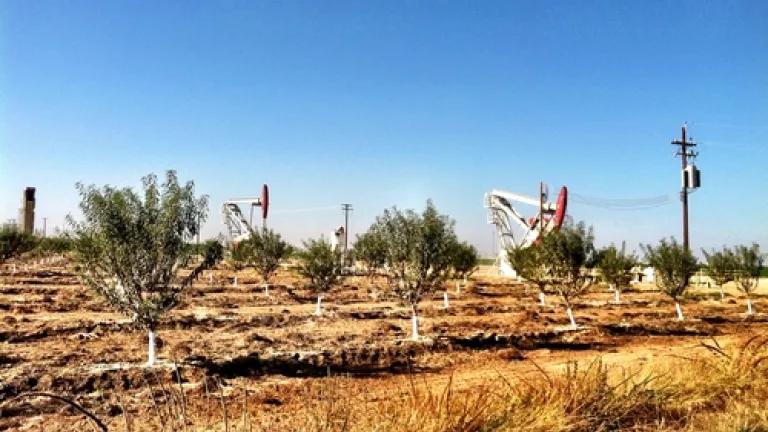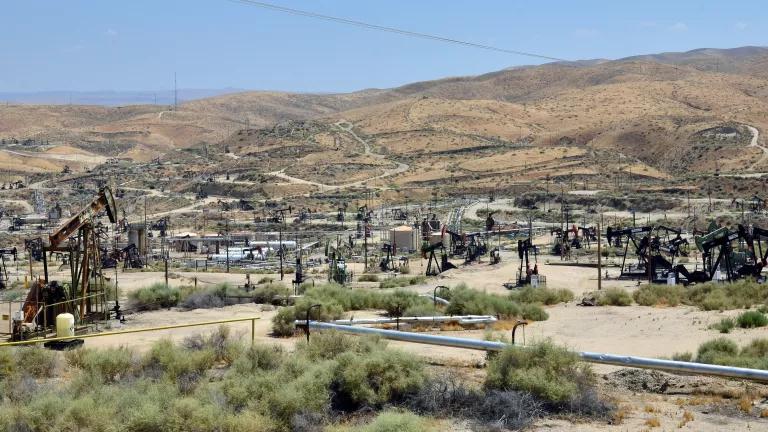Who's to Blame for Oil Waste in Californians' Drinking Water?
New information shows decades of mismanagement and failure to safeguard federally protected drinking water aquifers

NRDC
New information from the California Division of Oil, Gas, and Geothermal Resources (DOGGR) reveals that decades of poor record-keeping, lax oversight, and - in some cases - outright defiance of the law has allowed oil and gas operators to inject potentially toxic oil and gas wastewater into federally protected drinking water aquifers.
The extent of any contamination remains unknown, but the information exposes the cozy relationship that has existed between regulators and the oil and gas industry and the abject failure of both the State of California and the Environmental Protection Agency (EPA) to safeguard California's already scarce and drought-threatened drinking water resources.
Every year the oil and gas industry generates hundreds of billions of gallons of wastewater, also known as "produced water." The most common method for disposing of this waste is injecting it underground - an estimated 90 to 99 percent of oil and gas wastewater is managed through this practice. Produced water can be many times saltier than seawater and contain heavy metals, hydrocarbons, and naturally occurring radioactive material. Once an aquifer is contaminated with this fluid it can be extremely difficult, if not impossible, to clean up.
While most oil and gas wastewater nationwide is injected into geologic formations containing fluids that aren't suitable for drinking, irrigation, or other purposes, in some cases oil and gas companies want to inject waste into formations containing water that meets the federal definition of an "Underground Source of Drinking Water" (USDW). In order to do so, companies must first demonstrate that this water is not suitable and/or is unlikely to be used as drinking water and obtain what's known as an "aquifer exemption."
California has granted more than 1,100 such exemptions, most of which date back to the early 1980s when the Underground Injection Control (UIC) program was first created. But confusion over exactly which aquifers are exempt and where the boundaries of those exemptions are - coupled with a laissez-faire attitude on the part of regulators up until now to resolving those questions - has resulted in at least 2,553 wells being permitted to inject oil and gas waste and other fluids into non-exempt aquifers - aquifers that may contain clean drinking water. Given that California is also experiencing its worst drought in 1,200 years, it's hard to overstate just how thoroughly the regulatory system has failed.
DOGGR also released a plan to begin to address this huge mess, including:
- Continuing to review wells potentially injecting into non-exempt aquifers to determine the risks to groundwater;
- Creating processes to evaluate aquifer status and proposals for new aquifer exemptions;
- Improving communication with the public about the aquifer exemption process and the UIC program;
- Ensuring that existing or new injection into non-exempt aquifers is either phased out or covered by an aquifer exemption;
- Reviewing and revising, as necessary, California's UIC regulations, and;
- Creating a searchable database of Class II wells and aquifer exemptions.
We support these crucial steps and look forward to working with DOGGR and other relevant agencies to see that these goals are achieved. However, DOGGR's plan will allow injection into potentially non-exempt aquifers to continue for up to two more years, while the aquifers are being evaluated. This is not sufficiently protective of California's groundwater supplies, and as such, we're calling on California's elected officials, regulators, and the EPA to take action to:
- Immediately halt any further illegal injection into protected drinking water until the status of those aquifers is confirmed and the presence and extent of any contamination is determined;
- Undertake a full review the aquifer exemption program, including an evaluation of whether such a program should continue to exist at all in our increasingly water-constrained world.
Continuing injection into potentially non-exempt aquifers for two more years could allow any contamination to spread.
DOGGR's plans indicate that they will continue to process aquifer exemptions under the existing criteria, which were created more than 30 years ago. During that time, drought and scarcity have driven people to use water of lower quality and the technology available to treat groundwater has evolved significantly, meaning that water not previously considered usable may now be a critical resource. Continuing to grant aquifer exemptions under these outdated criteria is not acceptable.
We are hopeful that the era of industry being able to write its own rules is coming to an end with new leadership at DOGGR. We are encouraged by recent stakeholder meetings with leaders in the administration during which they've stated their priorities to improve transparency and record keeping at the department. The state can put these priorities into action by placing public health and protection of our precious water resources ahead of industry profit.


